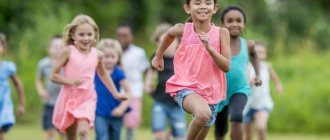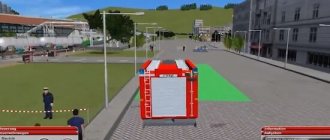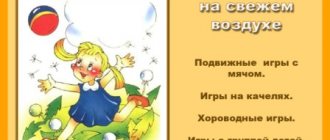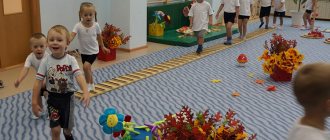Story games walk
- Butterflies - children in the role of butterflies, a teacher with a net, says:
- Let's wrap the thread - children in a line, teacher in front. Children are invited to become threads and wind themselves on a spool. Everyone follows the teacher, spinning in a circle, saying:
- Crows - the children pretend to be crows.
- Bees – children turn into bees, flap their wings and run around the playground. The teacher plays a bear:
The bees are buzzing, the bear is catching up with them. - cat house – lay out watering cans, ladles, buckets. Children stand in a line and say:
The teacher rings the bell, the children take the attributes and run to extinguish the makeshift house. At the end they say:
Outdoor games can be focused on running and activity, or they can be combined with role-playing games, when the child transforms into a hero. In this case, time on the playground will fly by quickly and interestingly.
Walking card index of games
- Kite and hen - the kite catches the chickens, the hen protects.
- Who can line up the fastest - each group of children has their own object, which the teacher moves while the children are running. You need to have time, at the signal, to line up in a column near your object, which has yet to be found.
- Owl - one child is an owl, the rest are birds. The owl sleeps during the day and catches birds at night.
- Tag - after the signal, the driver catches the children while they are running away.
- Change of places - teams are in ranks, running towards each other and trying to line up again. The one who becomes faster wins.
Precautionary measures
An adult who organizes outdoor games for children must clearly know the rules and essence, certain movements, in order to be able to easily explain them to children. Before the start of the game, it is necessary to inspect the site, check special devices, equipment, benches, stands for damage and breakage. Children's shoes and clothing should be appropriate for their age and season, not restrict movement or loosen.
During the game, the adult must organize the children so that they do not injure themselves and each other. You need to instruct your child that when jumping and dismounting, you need to land lightly on your toes, crouching slightly. This will compensate for the body's load on the legs.
It is important to alternate active, energetic games with calm and intellectual games. In the summer, it is better to play in a place on the site where there is shade and coolness. In winter, you need to jump and run more to keep warm.
After the games are over, you need to check how the children are feeling and collect sports equipment and toys. Even though children are warmed up, they should not be given cold water to drink or allowed to walk around undressed in cool weather.
How are outdoor outdoor games beneficial for children?
Outdoor games have a positive effect on a child’s physical activity and development. Children learn orientation in space, their coordination of movements improves. In addition, energetic games give the child a lot of positive emotions, which have a beneficial effect on his mood and health.
Children who often love outdoor games eat with great appetite, fall asleep easily and sleep soundly, and are less susceptible to whims and sudden mood swings. If a baby leads an inactive lifestyle in early childhood, then at an older age he will quickly get tired.
High physical activity is an excellent prevention of health problems such as muscle weakness and obesity. Most children's outdoor games involve active interaction with other children and adults. Therefore, the child socializes well, learns to quickly react to different situations in life and communicate with peers.
What exactly do street outdoor games develop?
During the game, certain skills are mastered and improved, the work of internal organs of all systems is activated, and brain function improves. Physical, psychological and social qualities develop.
The main physical qualities that enhance outdoor play are:
- Force;
- Agility;
- Flexibility;
- Rapidity;
- Endurance.
Outdoor games, especially competitions, are good for developing analytical thinking in a child. In addition, the following intellectual qualities improve:
- Logics;
- Deduction;
- Critical thinking;
- Abstract thinking;
- Ability to forecast;
- Creative thinking;
- Long-term concentration on solving a specific problem.
By interacting with peers in play, the child learns communication skills, to be tolerant of mistakes, to work in a team, and to solve common problems. Children learn to distribute responsibilities among themselves and share responsibility together. They learn to give in to each other, compromise and listen to the opinions of other children. The main social qualities that joint outdoor games develop in children are:
- Independence;
- Hard work;
- Kindness;
- Courage;
- Honesty;
- Respect;
- Responsibility;
- Self-confidence.
Card index of games for 6-7 years old
The movement of the carousel gradually slows down. At the words “The game is over,” the children lower the cord to the ground and disperse around the playground. After the children have rested a little, the teacher gives a signal (bell, whistle, clapping, hitting a tambourine), according to which the players again stand in a circle, take hold of the cord, i.e., take their places on the carousel. The game is resumed and repeated 3-4 times.
Directions.
The teacher can instruct the children to quickly stand in a circle using conventional signals when repeating the game. A player who does not have time to take a seat before the third signal does not take part in the next ride on the carousel, but waits for the next boarding.
TRAPPING IN A CIRCLE
Goal: Develop the ability to operate in a limited space; agility and speed
A circle is drawn on the ground, the diameter of which is 3-5 m. Using a counting rhyme, the players choose a trap. He stands in the center of the circle, the rest of the children are behind the circle. After the teacher’s words: “One, two, three - catch it!” the children run across the circle, and the trap catches them. You can only fish in a circle. When a certain number of children are caught, a new trap is chosen.
WHERE DID IVANUSHKA BATH?
At this time, the teacher touches all the children one by one with folded palms and quietly lowers a pebble to one of them.
At the end of the text, all palms should be closed. Ivanushka turns to the players and tries to guess who has the pebble.
If he guesses right, he sits in the place of the child who had the pebble, and he becomes Ivanushka. If he doesn’t guess correctly, he leads again. Without guessing the next time, he sits down on the end of the bench, and Ivanushka gets out again.
When children have mastered the game well, they organize it themselves, choosing the leader and Ivanushka using a counting rhyme.
TRAP, GET THE TAPE!
Goal: Develop dexterity.
The players stand in a circle. Each of them has a colored ribbon that is placed behind the belt or collar. There is a trap in the center of the circle. At the teacher’s signal “run,” the children scatter around the playground. The trap runs after the players, trying to take a ribbon from one of them. The one who has lost his ribbon temporarily moves aside. To the teacher’s words “One, two, three - quickly run into the circle!” children line up in a circle. The catcher counts the number of ribbons taken and returns them to the children. The game continues with a new trap.
Directions.
The same trap can be cast 2-3 times. The game task becomes more complicated by reducing the length of the ribbon.
DON'T GET YOUR FEET WET
Goal: Develop balance. Learn to act in concert.
The players gather on one side of the court behind the line. The teacher calls 5-6 children, they go to the line, each receives 2 boards (30 X 20 cm). On the opposite side of the site, plumes are laid out on the same line. Between the players and the benefits there is a swamp. Children must cross the swamp on planks without getting their feet wet (stepping only on the planks). At the teacher’s command “Begin!” the players put one board and stand on it, then move to another board, take the one from behind to put it in front of them again, etc. Having crossed the swamp, the children collect the boards, take the plumes and raise them above their heads. It is noted who raised the plume first. Then the children put the sultanas back, return to their places and pass the planks to the next ones.
Tips for parents
Children playing together with their parents benefits both. Children experience joy and bright emotions, and adults can get to know their child better and become closer to him. This is important in order to make childhood unforgettable and interesting for the child. Therefore, do not be lazy to play with him, do not be afraid to seem frivolous and funny, be a friend to him.
The games discussed in the article can be played both in the yard of the house and in a preschool or summer camp.
If you liked the article, please share a link to it






